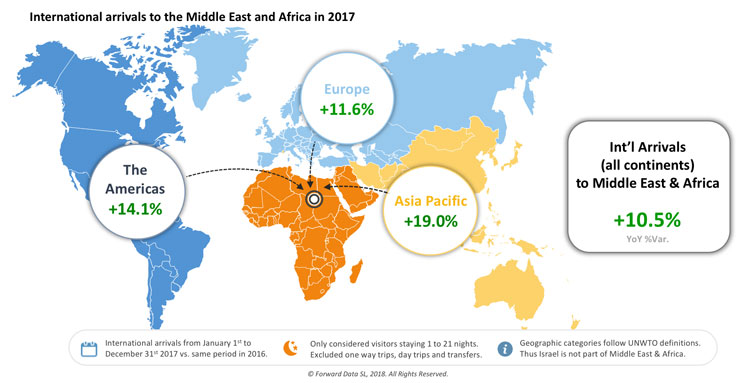ForwardKeys, a company that analyses air travel using reservation data, has disclosed that air travel to Africa and the Middle East increased by 10.5 percent in 2017. The company also predicts that more growth will be experienced in 2018’s first quarter.
“For travel to the Middle East and Africa, both the past year and the outlook for the coming quarter can be summed up in just three words: Double-Digit Growth,” Olivier Jager, ForwardKeys CEO stated.
The growth in air travels has been caused by North Africa’s recovery from terrorist attacks that took place in 2015, the amendment of visa regulatory frameworks aimed at increasing visitor numbers, and the growth of origin markets such as China.
In Africa, air travel to Tunisia increased by 29 percent despite facing devastating terrorist attacks in 2015. Tourists from Europe started visiting the country again at the close of the year 2016. In July 2017, the UK government removed a travel advisory against travel to the country. Egypt also recovered from a terrorist attack in 2015 by recording a 66.5 percent increase in group travel last year. Additionally, Morocco’s air travel increased by 17 percent in 2017 because of increased Chinese visitors and air capacity surge from the USA. Since June 2016, Chinese visitors travelling to Morocco have been enjoying new visa exemption. Countries such as Ghana, Uganda, Mauritius, and Gabon also enjoyed the benefits of visa liberalisation.
In the Middle East, Bahrain recorded 1 percent growth in 2017 while air travel to Qatar declined by 0.2 percent because of a diplomatic crisis with its neighbours.
Air travel bookings to Africa and the Middle East in the first quarter of 2018 indicate a 16 percent lead from the Americas, 13 percent from Europe, and 4 percent from Asia. Moreover, Argentina is showing a 34 percent growth compared to the first quarter of 2017. Rwanda could also record increased visitors because it will be granting visas to all visitors on arrival.



